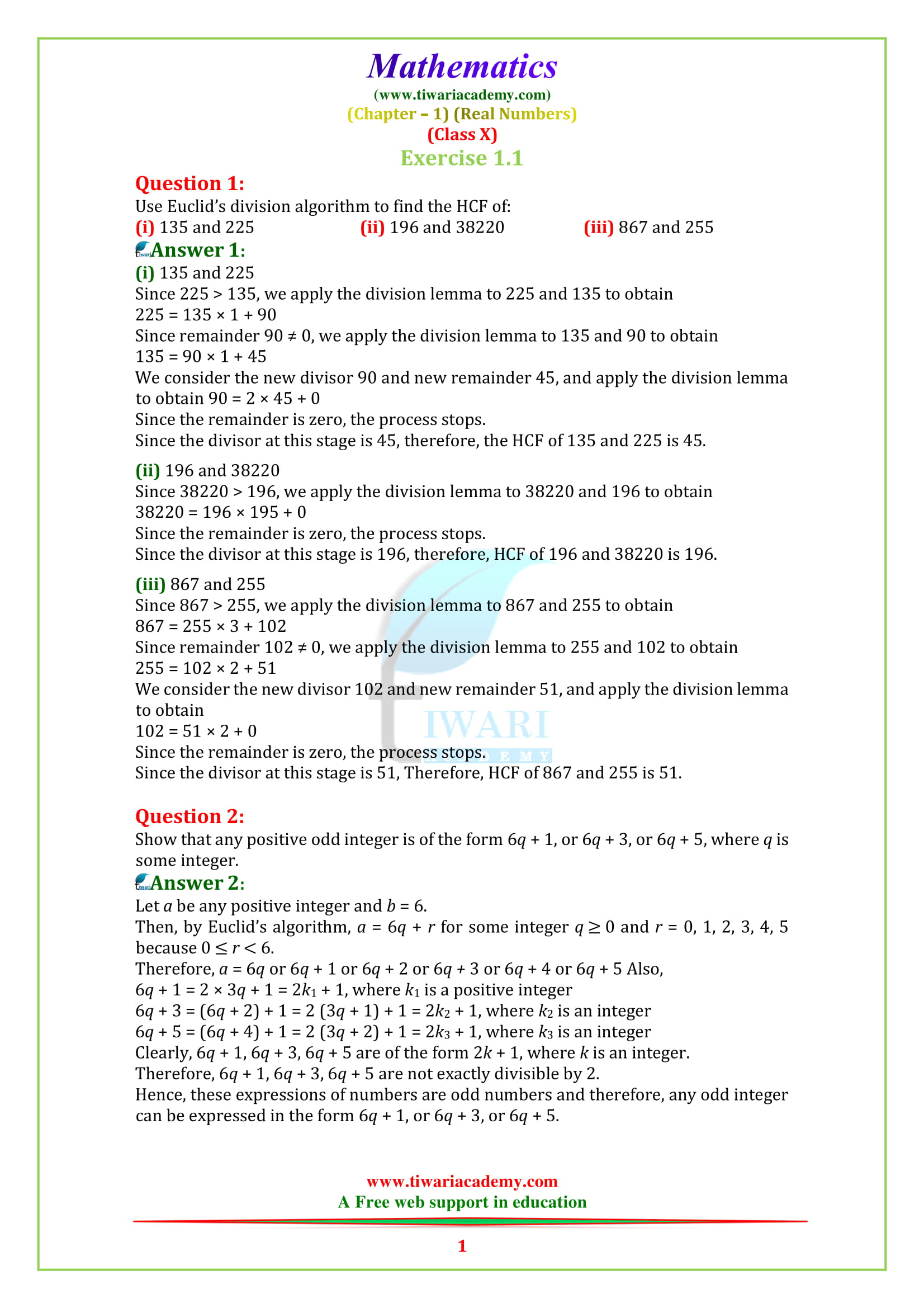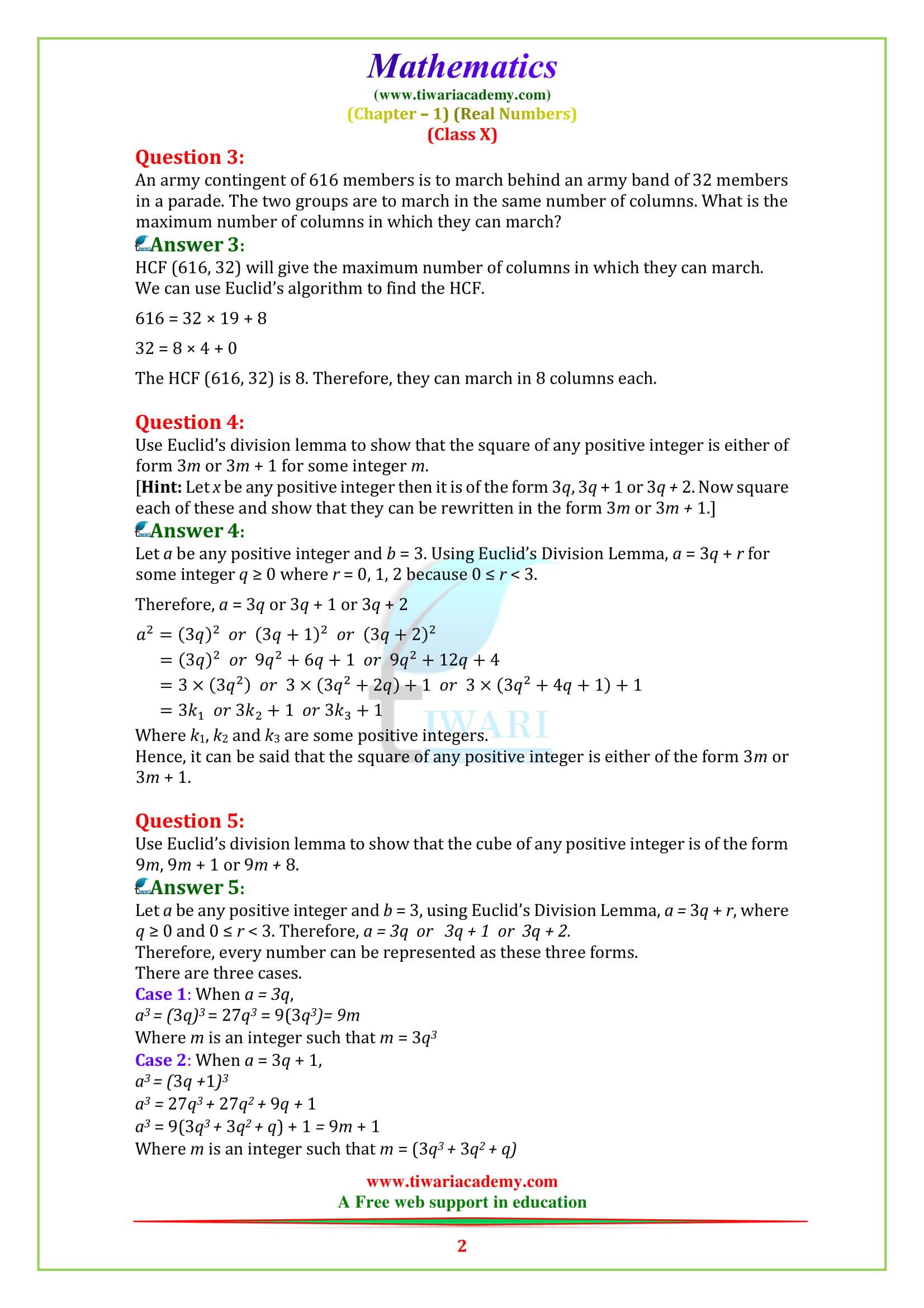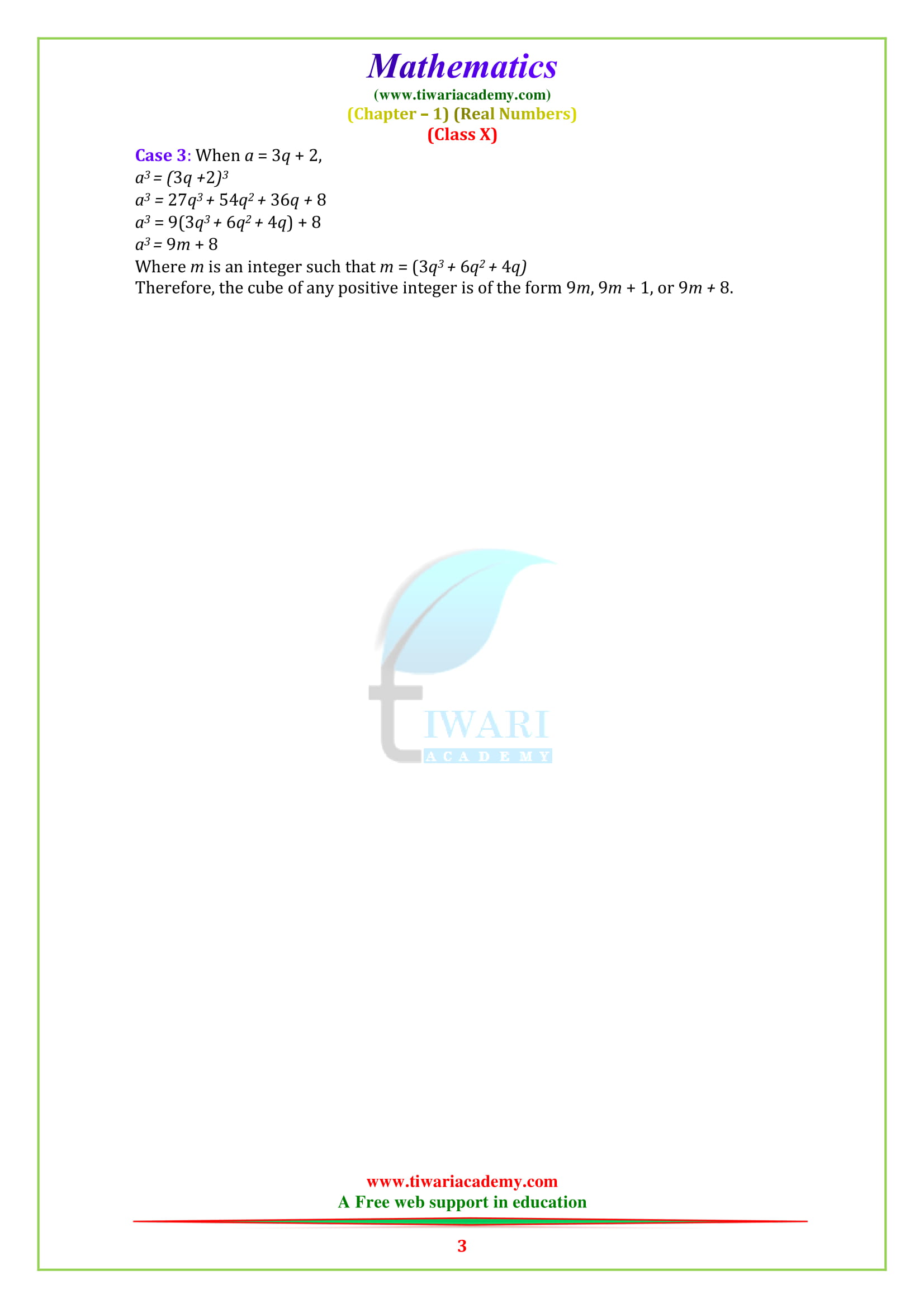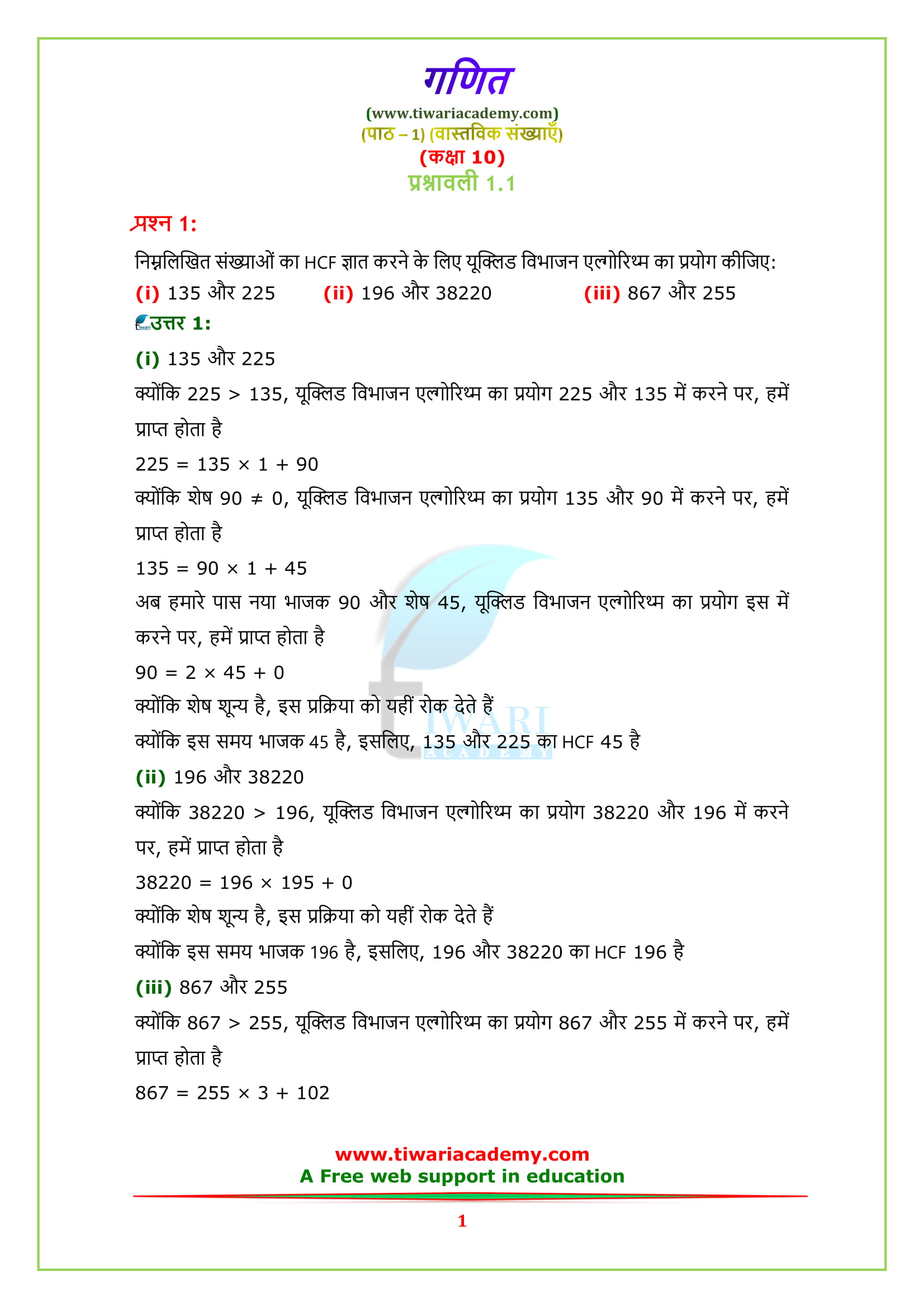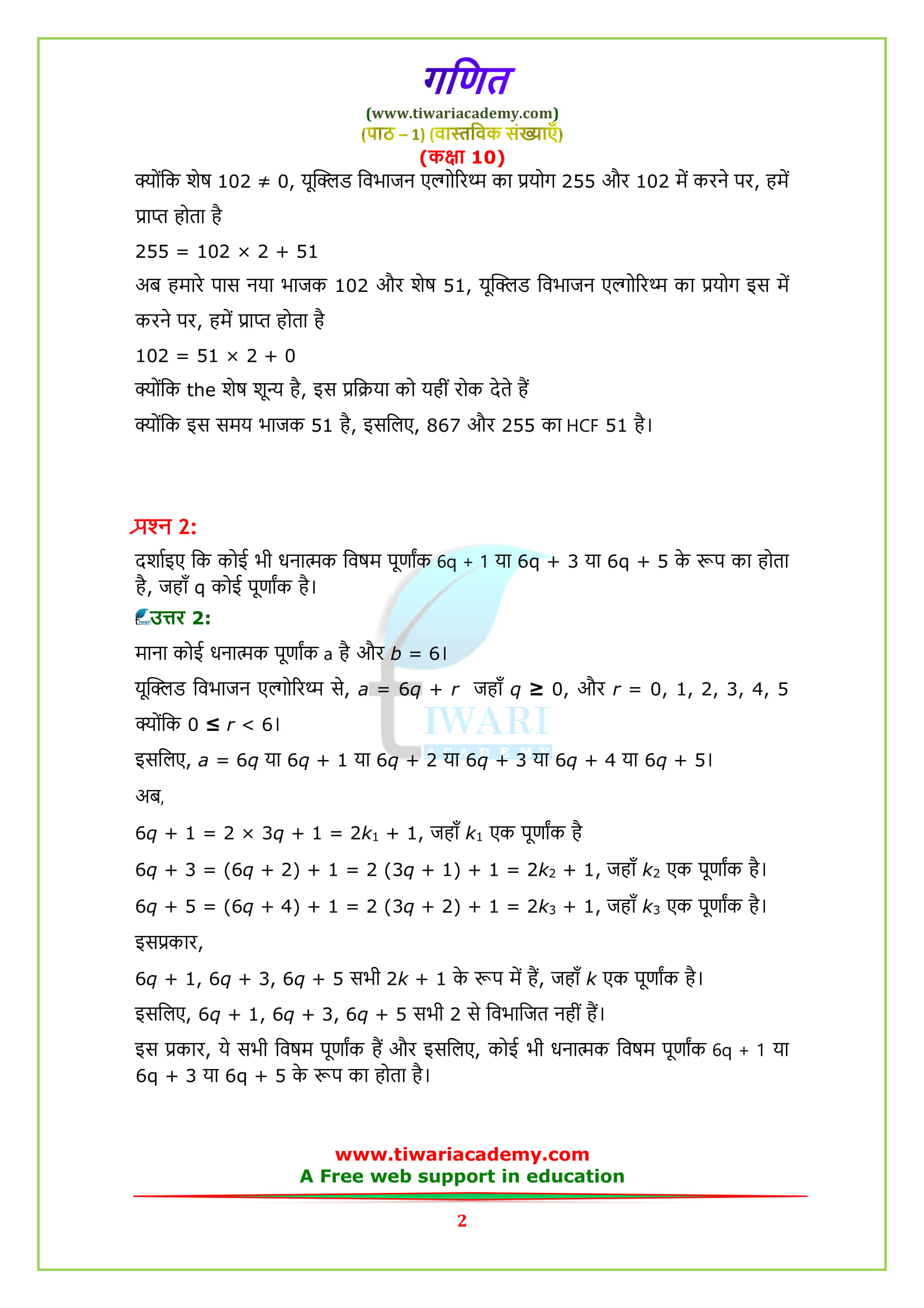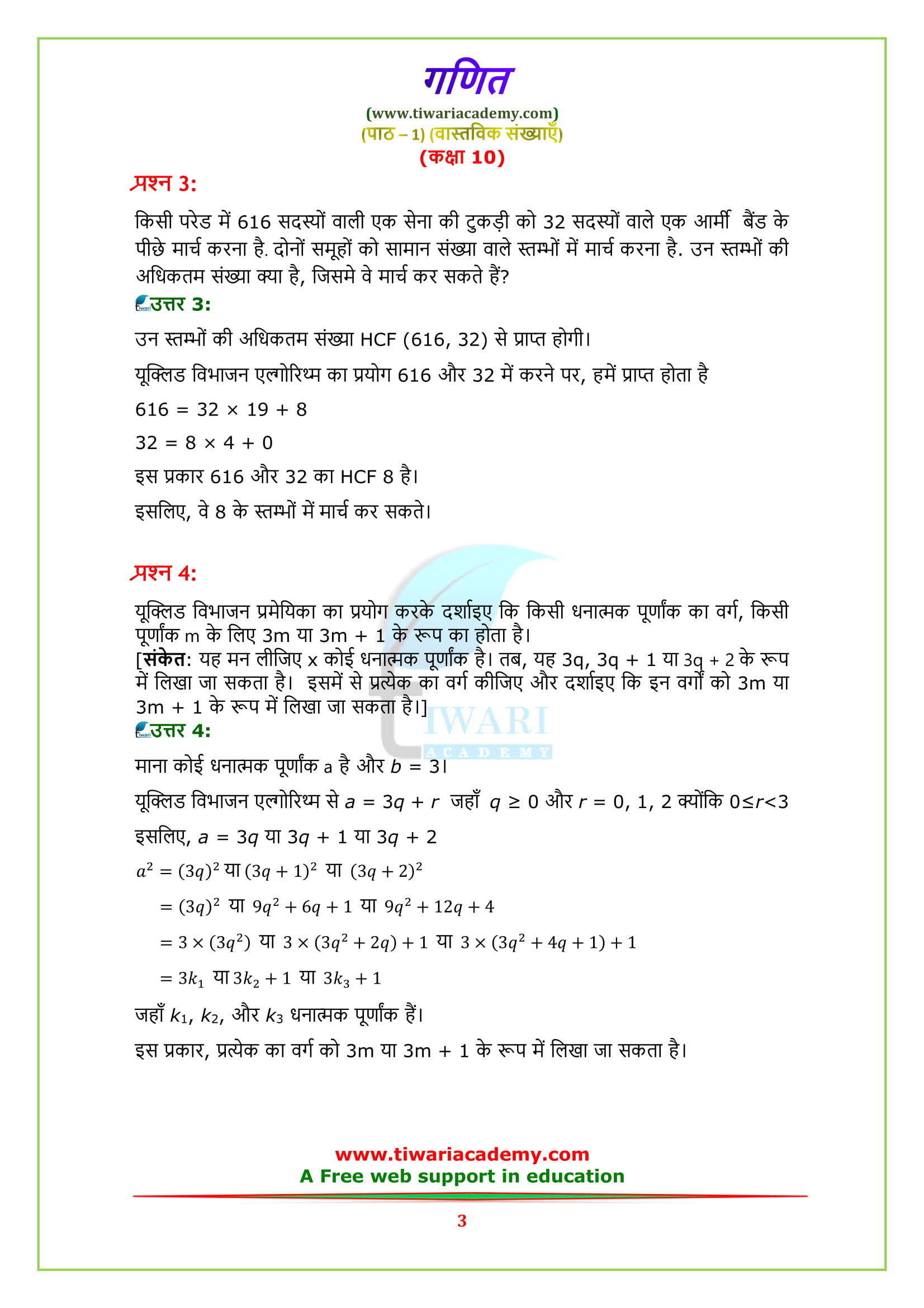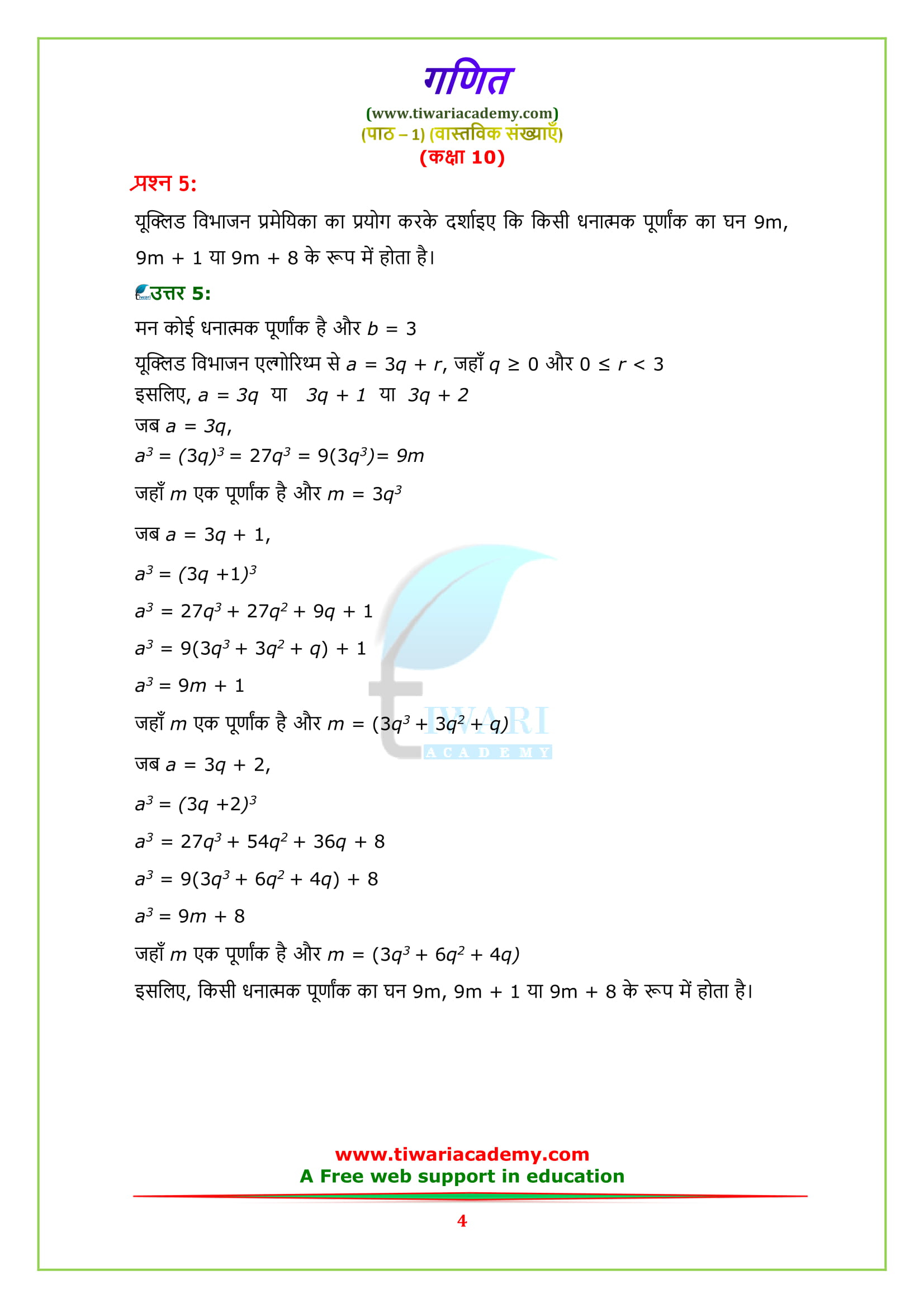NCERT Solutions for class 10 Maths Chapter 1 Exercise 1.1 Real Numbers in Hindi and English Medium. The explanation of 10th Mathematics Exercise 1.1 is suitable for the students of UP Board, MP Board and other state board High School.
NCERT Solutions for class 10 Maths Chapter 1 Exercise 1.1
Class 10 Maths Chapter 1 Exercises 1.1 Question 1 Solutions
Use Euclid’s division algorithm to find the HCF of:
- (i) 135 and 225
- (ii) 196 and 38220
- (iii) 867 and 255
Solution of Exercise 1.1 Question 1
- (i) 135 and 225
Since 225 > 135, we apply the division lemma to 225 and 135 to obtain
225 = 135 × 1 + 90
Since remainder 90 ≠ 0, we apply the division lemma to 135 and 90 to obtain
135 = 90 × 1 + 45
We consider the new divisor 90 and new remainder 45, and apply the division lemma to obtain 90 = 2 × 45 + 0
Since the remainder is zero, the process stops.
Since the divisor at this stage is 45, therefore, the HCF of 135 and 225 is 45. - (ii) 196 and 38220
Since 38220 > 196, we apply the division lemma to 38220 and 196 to obtain
38220 = 196 × 195 + 0
Since the remainder is zero, the process stops.
Since the divisor at this stage is 196, therefore, HCF of 196 and 38220 is 196. - (iii) 867 and 255
Since 867 > 255, we apply the division lemma to 867 and 255 to obtain
867 = 255 × 3 + 102
Since remainder 102 ≠ 0, we apply the division lemma to 255 and 102 to obtain
255 = 102 × 2 + 51
We consider the new divisor 102 and new remainder 51, and apply the division lemma to obtain
102 = 51 × 2 + 0
Since the remainder is zero, the process stops.
Since the divisor at this stage is 51, Therefore, HCF of 867 and 255 is 51.
Class 10 Maths Exercise 1.1 Question 1 Practice Assignment 1
Class 10 Maths Exercise 1.1 Question 1 Practice Assignment 2
Discuss 10th Maths Exercise 1.1 Question 1 Part 1
Discuss 10th Maths Exercise 1.1 Question 1 Part 2
Discuss 10th Maths Exercise 1.1 Question 1 Part 3
Class 10 Maths Chapter 1 Exercises 1.1 Question 2 Solutions
Show that any positive odd integer is of the form 6q + 1, or 6q + 3, or 6q + 5, where q is some integer.
Solution:
Let a be any positive integer and b = 6.
Then, by Euclid’s algorithm, a = 6q + r for some integer q ≥ 0 and r = 0, 1, 2, 3, 4, 5 because 0 ≤ r < 6.
Therefore, a = 6q or 6q + 1 or 6q + 2 or 6q + 3 or 6q + 4 or 6q + 5 Also,
6q + 1 = 2 × 3q + 1 = 2k1 + 1, where k1 is a positive integer
6q + 3 = (6q + 2) + 1 = 2 (3q + 1) + 1 = 2k₂ + 1, where k₂ is an integer
6q + 5 = (6q + 4) + 1 = 2 (3q + 2) + 1 = 2k₃ + 1, where k₃ is an integer
Clearly, 6q + 1, 6q + 3, 6q + 5 are of the form 2k + 1, where k is an integer.
Therefore, 6q + 1, 6q + 3, 6q + 5 are not exactly divisible by 2.
Hence, these expressions of numbers are odd numbers and therefore, any odd integer can be expressed in the form 6q + 1, or 6q + 3, or 6q + 5.
10th Maths Exercise 1.1 Question 2 Practice Assignment
Discuss 10th Maths Exercise 1.1 Question 2 in Detail
Class 10 Maths Chapter 1 Exercises 1.1 Question 3 Solutions
An army contingent of 616 members is to march behind an army band of 32 members in a parade. The two groups are to march in the same number of columns. What is the maximum number of columns in which they can march?
Solution:
HCF (616, 32) will give the maximum number of columns in which they can march.
We can use Euclid’s algorithm to find the HCF.
616 = 32 × 19 + 8
32 = 8 × 4 + 0
The HCF (616, 32) is 8. Therefore, they can march in 8 columns each.
Class 10 Maths Exercise 1.1 Question 3 Practice Assignment
Discuss 10th Maths Exercise 1.1 Question 3 in Detail
Class 10 Maths Chapter 1 Exercises 1.1 Question 4 Solutions
Use Euclid’s division lemma to show that the square of any positive integer is either of form 3m or 3m + 1 for some integer m.
Solution:
Let a be any positive integer and b = 3. Using Euclid’s Division Lemma, a = 3q + r for some integer q ≥ 0 where r = 0, 1, 2 because 0 ≤ r < 3.
Therefore, a = 3q or 3q + 1 or 3q + 2
a² = (3q)² or (3q + 1)² or (3q + 2)²
=(3q)² or 9q² + 6q + 1 or 9q² + 12q + 4
= 3×(3q²) or 3×(3q² + 2q) + 1 or 3×(3q² + 4q + 1) + 1
= 3k₁ or 3k₂ + 1 or 3k₃ + 1
Where k₁, k₂ and k₃ are some positive integers.
Hence, it can be said that the square of any positive integer is either of the form 3m or 3m + 1.
Class 10 Maths Exercise 1.1 Question 4 Practice Assignment
Discuss 10th Maths Exercise 1.1 Question 4 in Detail
Class 10 Maths Chapter 1 Exercises 1.1 Question 5 Solutions
Use Euclid’s division lemma to show that the cube of any positive integer is of the form 9m, 9m + 1 or 9m + 8.
Solution:
Let a be any positive integer and b = 3, using Euclid’s Division Lemma, a = 3q + r, where q ≥ 0 and 0 ≤ r < 3. Therefore, a = 3q or 3q + 1 or 3q + 2.
Therefore, every number can be represented as these three forms.
There are three cases.
Case 1: When a = 3q,
a³ = (3q)³ = 27q³ = 9(3q³)= 9m
Where m is an integer such that m = 3q³
Case 2: When a = 3q + 1,
a³ = (3q +1)³
a³ = 27q³ + 27q² + 9q + 1
a³ = 9(3q³ + 3q² + q) + 1 = 9m + 1
Where m is an integer such that m = (3q³ + 3q² + q)
Case 3: When a = 3q + 2,
a³ = (3q +2)³
a³ = 27q³ + 54q² + 36q + 8
a³ = 9(3q³ + 6q² + 4q) + 8
a³ = 9m + 8
Where m is an integer such that m = (3q³ + 6q² + 4q)
Therefore, the cube of any positive integer is of the form 9m, 9m + 1, or 9m + 8.
Class 10 Maths Exercise 1.1 Question 5 Practice Assignment
Discuss 10th Maths Exercise 1.1 Question 5 in Detail
| Class: 10 | Maths (English and Hindi Medium) |
| Chapter 1: | Exercise 1.1 |
10 Maths Chapter 1 Exercise 1.1 Solutions
NCERT Solutions for class 10 Maths Chapter 1 Exercise 1.1 of Real numbers in English & Hindi medium to use it online or download in PDF format. All the solutions are updated for new academic session 2025-26. Download Offline Apps for offline use.
Class 10 Maths Exercise 1.1 Solutions in Hindi Medium Video
Important Terms related to Real Numbers
1. Euclid’s division Lemma: For given positive integers ‘a’ and ‘b’ there exist unique whole numbers ‘q’ and ‘r’ satisfying the relation a = bq + r, o ≤ r < b.
2. Euclid’s division algorithm: HCF of any two positive integers a and b with a > b is obtained as follows:
Step 1 : Apply Euclid’s division lemma to a and b to find q and r such that a = bq + r, 0 ≤ r < b.
Step 2 : If r = 0 then HCF (a, b) = b ; if r ≥ 0 then again apply Euclid’s lemma to b and r.
Repeat the steps till we get r = 0
3. The fundamental Theorem of Arithmetic: Every composite number can be expressed (factorized) as a product of primes and this factorization is unique, apart from the order in which the prime factors occur.
Important Questions for Practice on 10th Maths Chapter 1
- Write the general form of an even integer. [Answer: 2m]
- Find the largest integer which divides 245 and 1029 leaving remainder 5 in each case. [Answer: 16]
- Write the form in which every odd integer can be written taking t as variable. [Answer: 2t +1]
- If the HCF of 408 and 1032 is expressible in the form 1032y – 408×5, then find y. [Answer: 2]
- What would be the value of n for n²–1 divisible by 8. [Answer: An odd integer]
- Two tankers contain 650 litres and 1170 litres of petrol respectively. Find the maximum capacity of a tanker which can measure the petrol of either tanker in exact number of times. [Answer: 130 litres]
- State whether 7 × 11 × 13 + 7 is a composite number or a prime number. [Answer: Composite]
- A bookseller purchased 117 books out of which 45 books are of mathematics and the remaining 72 books are of Physics. Each book has the same size. Mathematics and Physics books are to be packed in separate bundles and each bundle must contain the same number of books. Find the least number of bundles which can be made for these 117 books. [Answer: 13]
- Is 5.131131113… a rational number or irrational number? [Answer: Irrational]
Important qustions from 10th Maths Exercise 1.1
Show that the square of any positive integer cannot be of the form (5q + 2) or (5q + 3) for any integer q. [CBSE 2020] [Maths Standard]
Let a be any positive integer and b = 5. Using Euclid’s Division Lemma, a = 5q + r for some integer q ≥ 0 where r = 0, 1, 2, 3, 4 because 0 ≤ r < 5. Therefore, a = 5q or 5q + 1 or 5q + 2 or 5q + 3 or 5q + 4 a² = (5q)² or (5q+1)² or (5q+2)² or (5q+3)² or (5q+4)² = (5q)² or 25q² + 10q + 1 or 25q² + 20q + 4 or 25q² + 30q + 9 or 25q² + 40q + 16 = 5(5q²) or 5(5q² + 2q) +1 or 5(5q² + 4q) + 4 or 5(5q² + 6q + 1) +4 or 5(5q² + 8q + 3) + 1 = 5k₁ or 5k₂ + 1 or 5k₃ + 4 or 5k₄ + 4 or 5k₅ + 1 Where k₁, k₂, k₃, k₄ and k₅ are some positive integers. Hence, it can be said that the square of any positive integer cannot be of the form (5q + 2) or (5q + 3) for any integer q.
Prove that one of every three consecutive positive integers is divisible by 3. [CBSE 2020] [Maths Standard]
Let a, a + 1, a + 2 be any three consecutive positive integers and b = 3. Using Euclid’s Division Lemma, a = 3q + r for some integer q ≥ 0 where r = 0, 1, 2 because 0 ≤ r < 3. Therefore, a = 3q or 3q + 1 or 3q + 2 Here 3q is divisible by 3. For next number a + 1 = 3q + 1 or 3q + 2 or 3q + 3 Here 3q + 3 is divisible by 3. For next number a + 2 = 3q + 2 or 3q + 3 or 3q + 4 ⇒ a + 2 = 3q + 2 or 3q + 3 or 3(q + 1) + 1 Here 3q + 3 is divisible by 3.
An army contingent of 612 members is to march behind an army band of 48 members in a parade. The two groups are to march in the same number of columns. What is the maximum number of columns in which they can march? [CBSE 2020] [Maths Basic]
HCF (612, 48) will give the maximum number of columns in which they can march.
We can use Euclid’s algorithm to find the HCF.
612 = 48 × 12 + 36
48 = 36 × 1 + 12
36 = 12 × 3 + 0
The HCF (612, 48) is 12. Therefore, they can march in 12 columns each.
What do you understand by Lemma?
A lemma is a proven statement used for proving another statement.
Download NCERT Books and Offline apps based on new CBSE Syllabus. Ask your doubts and share your knowledge with your friends and other users through Discussion Forum 2025-26.
How many questions are there in exercise 1.1 of class 10th Maths chapter 1 Real numbers?
There are in all 5 questions in exercise 1.1 of class 10th mathematics chapter 1 (Real numbers). Question number 2, 4 and 5 are based on same concept (Euclid’s Division Lemma) and question number 1 and 3 are based on same concept (Euclid’s Division Algorithm).
How many examples are based on exercise 1.1 of class 10th mathematics?
4 examples are based on exercise 1.1 (chapter 1 Real numbers) of class 10th mathematics. Examples 2, 3 and question 2, 4 and 5 are based on Euclid’s Division Lemma and examples 1, 4 and questions 1, 3 are based on Euclid’s Division Algorithm.
Which are the Important as well as difficult questions from exercise 1.1 Class 10th Math?
All questions of exercise 1.1 of class 10th mathematics chapter 1 (Real numbers) are important and difficulty level of questions varies from student to student. But questions which most of students find little difficult are Question 2, 3, 4, and 5.
Which topics students should recall before starting exercise 1.1 10th Math?
Before starting exercise 1.1 (chapter 1 Real numbers) of class 10th mathematics, Students should recall:
- Topic 1: HCF (Highest Common Factor).
- Topic 2: Meaning of Dividend, Divisor, Quotient and Remainder.
What are the theorems and algorithm on which Exercise 1.1 of class 10th Maths chapter 1 based?
Exercise 1.1 of class 10th mathematics chapter 1 (Real numbers) is based on Theorem named Euclid’s Division Lemma and Algorithm named Euclid’s Division Algorithm.
